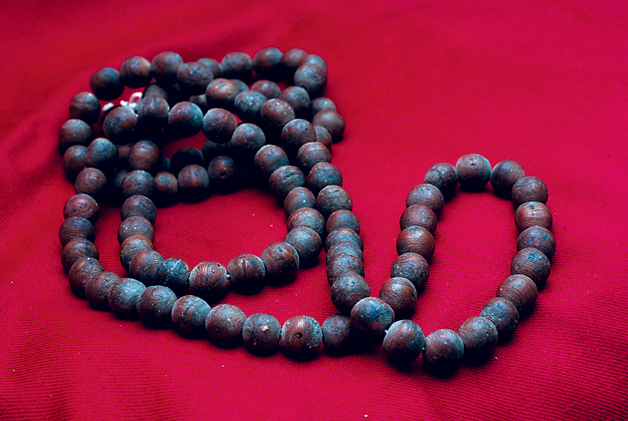 The number 108 is considered sacred and supreme all across the Indian subcontinent and in Tibet and Mongolia, among Hindus and Buddhists, alike. Besides the Tibetan Buddhist scriptures and the Hindu Vedanta, it is also found in Christianity and Islam. It would be an overstatement to consider that the number carries an ethereal or heavenly sway. But because of the symbolic values attached to it, an occultist reverence is given to it even today. The omnipresence of the number in almost every spiritual and religious context attests to the special respect bestowed to it.
The number 108 is considered sacred and supreme all across the Indian subcontinent and in Tibet and Mongolia, among Hindus and Buddhists, alike. Besides the Tibetan Buddhist scriptures and the Hindu Vedanta, it is also found in Christianity and Islam. It would be an overstatement to consider that the number carries an ethereal or heavenly sway. But because of the symbolic values attached to it, an occultist reverence is given to it even today. The omnipresence of the number in almost every spiritual and religious context attests to the special respect bestowed to it.
The modern numerological system originated on the Indian subcontinent. The primitive Aryans are sometimes credited with the development of modern numbers; hence, it comes as no surprise that Hindus associated various myths and folklore to the numerological system they developed. But among all the numbers, 108 has always been considered the most auspicious and propitious. As one encounters various aspects of Hindu-Buddhist tradition, the number appears to be ubiquitous and pervasive.
For instance, there are 108 beads struck in a jaap-mala (prayer beads) and an estimated 108,000 Shiva lingams in and around Kathmandu’s Pashupatinath temple. Lord Krishna is supposed to have befriended 108 gopis (cow-herders). There are various sets of logic and reasoning attached to the number, but in the hustle of the modern world few bother to unearth them.
Plainly observing, the three digit number is not the largest nor does it have any direct connections with primordial Hindu beliefs. Modern numerology books state that ‘one’ (1) stands for god or higher truth, ‘zero’ (0) stands for emptiness or completeness in spiritual practice and ‘eight’ (8) stands for infinity () or eternity. The straightforward implication of meaning of the digits does not seem to justify the true meaning of the triple digit figure. Therefore, sleuthing through the unseen and unheralded components that make out the dimension of this important number is the only way to unravel the mystery behind it.
Numbers are used as reference frames. Reference frames stand for the basic components of measurement. They are a starting point for all types of measurement. In Hindu belief numbers are used to measure emotions; hence, in Sanskrit script, the number 108 is a ‘joyful’ number called a harshad, meaning it is an integer that is divisible by the sum of its digits. Harshad in Sanskrit means great joy.
The Aryans who developed the devanagari lipi (script) assigned the Sanskrit alphabet doubly to both male and female—the 54 letters in both genders equals 108. Thus, respecting the entirety of human race, it symbolises the equality that is supposed to grace both genders.
According to Vedic science, marmasthanas are energy intersections called chakras, which have few energy lines converging to form them. There are said to be 108 marmasthanas in a human body. A total of 108 energy lines, likewise, converge to form the heart chakra. One of them, sushumna, leads to the crown chakra and is said to be the path to self-realization. It is said, if one is able to be so calm in meditation as to have only 108 breaths in a day, enlightenment will come. Moreover, the Vedas state that atman, the human soul, goes through 108 stages on the journey.
Lord Shiva was once in deep meditation. His samadhi (the highest stage of meditation) created a great heat in the universe, and as all existence was in peril Lord Brahma was deeply concerned. Brahma asked Shakti, Mother of the Universe, to use her wiles to seduce Lord Shiva. She agreed and appeared to Shiva as Sati, the daughter of Shri Daksha, the first king of the universe. Lord Shiva was so entranced by Sati’s extraordinary beauty and asceticism that he took human form and they were married. Years later, at a mahayagna (‘great oblation’), Sati’s father insulted Shiva at which Sati was so humiliated that she jumped into the yagya fire. Shiva was heartbroken. He pulled as much of Sati’s body from the sacrificial fire as he could, and while ascending to the heavens 108 bits of her body fell to earth. The places where the body parts fell in Nepal and India are worshipped as Shaktipeeths. In Kathmandu one is at Guheshwari temple, behind Pashupatinath.
There are many other beliefs about the mystical number 108. For example, it is often said that the Upanishads are divided into 108 parts (when, in fact, there are 200 parts). It is also thought that the jaap-mala numbers 108 beads, though in fact there are 100 beads with an extra eight added to cover errors or omissions. Those eight beads are also said to be an offering to god and guru (one’s teacher).
So why did the Aryans pick 108 and create such profound myths around the number? The Jyotish Shashtra (the Vedic science of astrology) makes extensive use of mathematics and there in one might find the answer to the mysticism of 108.
JYOTISH SHASTRA (Vedic astrology)
The universe was created of the five elements: water, air, fire, earth and sky (or space). The interplay between these essential elements of creation results in raj (birth), sat (protection) and tam (destruction or death). The mathematical and geographical evidence have proven that a circle has 360 degrees in space. The circle is considered the first element of space, since we must consume space in drawing a circle. In this space (or circle) the four remaining elements and three attributes create the idea of time. The circle, therefore, is what contains the four elements and the three attributes, and is a product of their multiplication. This involves the belief that the three attributes exist in the circle. By moving three times, each element completes its revolution.
So now we have the number 12 (3 x 4). This division gave birth to our 12 months, and also to the 12 horas (½ of the day or ahoratri). We now have 360 degrees as well as 12 divisions. If we further divide the wheel of time there are 27 fixed stars (nakshatras) along with three attributes that divide the time in smaller portions. So this 27 + 3 = 30 is interpreted as 30 degrees or days of one part of the wheel (circle) or month. All of this is only half of a day. The night is yet unaccounted for; therefore, by multiplying 30 degrees by 2 we have 60 seconds in a minute.
Thus the 360º x 30º = 10,800. Zero is considered purna, complete. Remove the last zeros and we are left with 108. The idea of our total universe is represented by this number, 108. By offering 108 devotees believe that they are showing ultimate or complete respect to the Supreme. What more is there?

The Goddess among Men: Chronicles of a former Kumari
Transition back to regular life wasn't easy for Preeti Shakya, a former Kumari. In that role, she was loved and...









